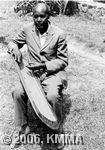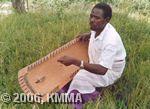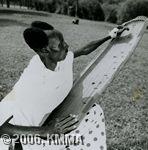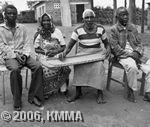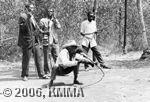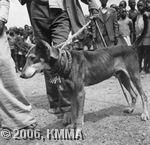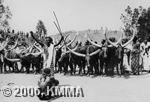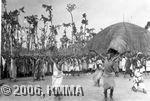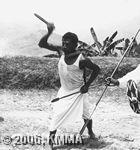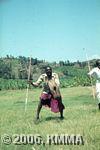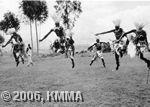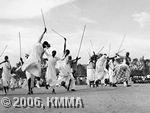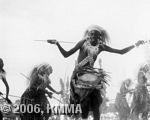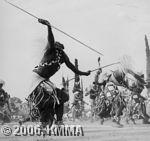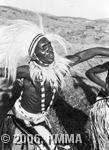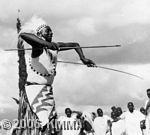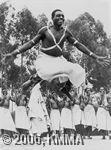MUSIC AND DANCE IN RWANDA
Introduction: the country and its inhabitants
Rwanda, one of the ancient kingdoms of southern Interlacustrine Africa, is now
a republic with 7,568,207 inhabitants (according to the population census of 31
December 1999). The country covers an area of 26,338 km2
and is divided into 12 provinces. Its language, Kinyarwanda, belongs to the Rwanda-Ha
linguistic-cultural group, which belongs to the Bantu language family. Kinyarwanda
has great similarities with the other two languages in this group, Kirundi and Giha
(a kind of dialect of the first), which are spoken in Burundi and Buha respectively,
two ancient neighbouring kingdoms that have many cultural similarities with Rwanda.
Besides Kinyarwanda, Rwanda has two other official languages, English and French.
A small proportion of the population speaks Swahili.
Rwanda is bounded on the west and the north-west by the Democratic Republic of
Congo and on the north by Uganda, as well as by Burundi on the south and Tanzania
on the east. Its orographic relief ranges from 1,000 m to 2,000 m above sea-level
(its range of volcanic mountains reaching more than 3,000 m high). This volcanic
mountain range (Birunga) stretches from the far eastern border of Congo to the
north-west of Rwanda and comprises six volcanoes, the highest, Karisimbi, reaching
4507 m high. Rwanda's main cities are Kigali, the capital, with more than 300,000
inhabitants (1999 estimate), Butare in the south, Gisenyi in the north-west and
Ruhengeri in the north. One of its five rivers, the Akagera - also known as the
Kagera River - is the longest headstream of the Nile.
The population of Rwanda is made up of three main ethnic groups: the Tutsi, the
Hutu and the Twa, who share the same language and the same culture and share the
same habitat of hills. These groups are mainly engaged in agriculture: subsistence
farming (beans, bananas, manioc [cassava], sweet potato, sorghum, peas and potatoes),
a few industrial crops such as coffee and tea, and livestock (cattle: Ankole cows,
and small livestock: goats, sheep, chickens and pigs [particularly in the south of
the country]). In the past some also practised a trade - some of them still
surviving today, although most of these now belonging to the past - and there were
also some secondary production activities, such as beekeeping, pottery, woodwork,
metalwork, alfa grass weaving and basketry, hunting and jewellery-making. Most of
these have disappeared or are disappearing as products made in the West are often
more practical or efficient. These various activities and trades have left Rwanda
with a wealth of music and literature, which are examined more closely below.
Culture
a) Cultural variation
As soon as you begin to look into Rwandan culture you are faced with the fact that this
culture does not present itself as one monolithic entity, even though a valid description
for the whole country could be conceived. There are two systems of cultural variation in
Rwanda (d'Hertefelt, 1962: 22): there is a vertical variation based on the differences
that exist between the three population groups, one which has been subject to considerable
changes since the end of the first monarchy; and a horizontal variation, that of the
regional differences, often studied from the cultural model of Central Rwanda. But these two
variations are correlative as, at the time of the monarchy, this was the region where the
élite Tutsi cultural and artistic model was concentrated, with the royal court which
developed a form of patronage in some areas of the arts and which was the place to which
zither-players, bards or singer-storytellers were invited and where they stayed for a
relatively short time, where tambourin-players and insengo whistle-players and royal
dancers stayed for prolonged and regular stays, and where certain musical and choreographic
genres developed (Gansemans, 1988: 27). This is also the region where a form of acculturation
rapidly developed between the three population groups, particularly between the Tutsis and
the Hutus. And cultural variation increases the further one moves away from the centre towards
the peripheral regions, where the central administration was unable to establish itself so
strongly and achieve the same model.
The different regions in respect of this cultural variation and in relation to this
treatise are, roughly speaking:
-
Central Rwanda (Gitarama, Kigali and part of Butare) its influence radiating towards the east and the south;
-
the north-north-western region (Ruhengeri-Gisenyi);
-
the north (Buberuka - Rukiga);
-
the ridge region (part of the current Gisenyi province, the current Kibuye and Gikongoro provinces,
i.e.: Kingogo, Budaha, Nyantango, Bwishaza, Buyenzi, Bunyambiriri and Bufundu);
-
the Kinyaga region with the Bukunzi-Busozo enclave next to it;
-
the regions of Ndorwa, Mutara, Mubari and Gisaka;
-
and the regions of Buganza and Bugesera.
In all these regions, the prevalent cultural traits were determined by the population group
that was represented in the highest proportion and by the various occupations and traditional
trades that were practised.
b) The arts
The traditional Rwandan artistic sense can be defined as expressing the 'beautiful' and
the 'utilitarian'. D'Hertefelt (1962: 73) says the following on the subject: "Art was
intimately linked with the trades people practised, with technical and professional
competence… The imitation of existing models was normative, particularly in the
literature of the court, which was the richest branch. Art developed through the
repetition and development of existing themes, motifs and techniques." It is not the
aim here to examine Rwandan art in general but to look at Rwandan music and dance, as
the title suggests. However, although decorative art is more closely linked to the
'utilitarian' (decoration of household objects, decoration of weapons of war with painted,
engraved and poker-worked drawings, etc.) music and dance also fit the 'utilitarian' label.
Music and dance were linked to historical events, celebrations, rituals and ceremonials,
which were enhanced by them. Only much later on did the royal court patronize artists and
groups of artists whose sole purpose was to give pleasure to the eye and ear with their performances.
MUSIC
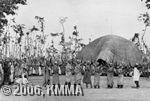
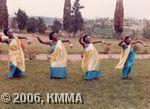 In Rwanda there is music that gives rise to dance, Imbyino, and music that is
simply for listening, Indirimbo. This art was often associated with poetry and
eloquence. Music, dance and poetry have always been the most spectacular expressions of
Rwandan culture. They constitute elements of identity and socialization and as such have
pervaded the lives of this nation of farmers, shepherds and herdsmen, potters and other
craftsmen. They are transmitted orally and reflect the history, the fundamental values, the
view of the world and the customs of the Rwandans.
In Rwanda there is music that gives rise to dance, Imbyino, and music that is
simply for listening, Indirimbo. This art was often associated with poetry and
eloquence. Music, dance and poetry have always been the most spectacular expressions of
Rwandan culture. They constitute elements of identity and socialization and as such have
pervaded the lives of this nation of farmers, shepherds and herdsmen, potters and other
craftsmen. They are transmitted orally and reflect the history, the fundamental values, the
view of the world and the customs of the Rwandans.
1) The Imbyino dance songs
The term imbyino is a noun that is derived from the verb kubyina, which has
a multitude of meanings: to perform a song accompanied by dance; to dance by stamping
one's feet on the ground to the rhythm of a song performed by the dancer and/or others.
The noun imbyino can therefore be defined as: popular song generally accompanied
by dance (The INRS Rwandan-French dictionary, abridged by Jacob). Dance songs were performed
at the royal court and gave rise to the dance called Umushagiriro, which has a slow
tempo and is danced with sliding steps. It is usually performed by women, with an emphasis on the
elegance of gestures and movements and showing off the body. According to some Rwandan choreography
experts this song is highly characteristic of Tutsi music with its refined complication of tones,
voices that are often high, its ornamentation and melismatics.

The other category of Imbyino songs are those that give rise to the dance called
Umudiho, a dance in which 'the feet are stamped on the ground with a certain
degree of force'; it varies depending on the dancers who dance it and in particular varies from
region to region
 .
This variation, which can be said to be horizontal, makes dance songs in Rwanda
one of the richest genres in the sphere of music and choreography. Dance songs possess the
characteristics that are inherent in the cultural traits of each of the three population groups.
There is a Tutsi type of dance song, there is a Hutu type of dance song and there is a Twa type
of dance song, defined by the subject matter, the melodic texture and the choreography. There is
also a female type of dance song and a male type of dance song. The richest horizontal variation,
however, is the regional variation. Each of the regions listed above possess a certain number of
characteristics that set one dance song apart from another. In choreographic terms and with
respect to the various regions, it has been noted that the umudiho dance can
be subdivided in two categories: 1) that with powerful steps and movements of the
ikinimba dance that is characteristic of the mountainous areas of the country
(Ruhengeri, Gisenyi, and Byumba in the north, and Kibuye-Gikongoro in the southwest and west
of Rwanda) and 2) that with less accentuated steps and movements in the rest of Rwanda,
which maintains the name umudiho. As such, since dance is a stylization
of the everyday activities and way of life of the group performing it, we have:
.
This variation, which can be said to be horizontal, makes dance songs in Rwanda
one of the richest genres in the sphere of music and choreography. Dance songs possess the
characteristics that are inherent in the cultural traits of each of the three population groups.
There is a Tutsi type of dance song, there is a Hutu type of dance song and there is a Twa type
of dance song, defined by the subject matter, the melodic texture and the choreography. There is
also a female type of dance song and a male type of dance song. The richest horizontal variation,
however, is the regional variation. Each of the regions listed above possess a certain number of
characteristics that set one dance song apart from another. In choreographic terms and with
respect to the various regions, it has been noted that the umudiho dance can
be subdivided in two categories: 1) that with powerful steps and movements of the
ikinimba dance that is characteristic of the mountainous areas of the country
(Ruhengeri, Gisenyi, and Byumba in the north, and Kibuye-Gikongoro in the southwest and west
of Rwanda) and 2) that with less accentuated steps and movements in the rest of Rwanda,
which maintains the name umudiho. As such, since dance is a stylization
of the everyday activities and way of life of the group performing it, we have:
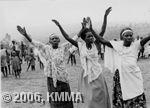





-
dance songs that evoke and recreate certain gestures and movements related to the
agricultural way of life;
-
dance songs that evoke the pastoral way of life, the themes of the songs relating
to breeding cows and their socio-economic value;
-
songs that evoke the warriors' way of life, the themes of the songs relating to
victories and conquests;
-
songs that evoke the hunters' way of life - although this way of life now really only
belongs to the past, some polyphonic dance arrangements of the Twa evoke it with nostalgia;
-
songs that recreate the rhythm of certain trades and socio-economic activities;
-
and ritual songs, more specific those of the Lyangombe and the Nyabingi cults.
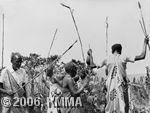
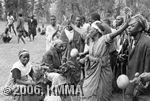
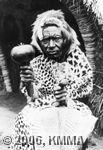
These activities and ways of life, however, are determined by a certain number of factors that
are related to the physical environment: the orography, hydrography, the climate or the social
environment, which the group concerned has had to deal with and harness, so that their dance
reflects and relates the way in which they went about dealing with and harnessing these.
a) Themes and contents of the dance songs
In the Imbyino dance songs, the steps and movements of the dance only become true forms
of expression and only take on the power of language through the song, which gives them their
name and their meaning. Indeed, it is by the name of the song, the style and the melody, and
the meaning of the words sung that the dances can be classified into one or other theme or sphere.
When do Rwandans dance? The Imbyino are performed at particular events in Rwandan social
life. A substantial repertoire of songs and dances is associated with marriage ceremonies.
Dance songs were also performed at the rites of the First Fruits, Umuganura, at evening
gatherings when friends or family were visiting, at drinking sessions after certain community
activities such as ploughing, putting a thatched roof on a hut, after a hunting expedition, at
the childbirth blessing ritual and at the naming of a newborn. The Imbyino dance was also
performed at other rituals and ceremonials at the royal court (D'Hertefelt et Coupez,
La Royauté Sacrée de l'Ancien Rwanda, RMCA Annals, 1964: pp. 21-23, 67-71) and
among the population, where dance served as a ritual element that enhanced the celebration or
as an act of magic associated with other curative, preventative or incantatory acts or acts of
jettatura. Among these rituals celebrated among the people, there are the dances performed in
the cult of Kubandwa or Lyangombe

 and in the cult of Nyabingi
and in the cult of Nyabingi
 ,
the latter
being performed particularly in the north of Rwanda. Bourgeois (1954: 628-269) describes other
settings in which magic ritual dances were performed, some of which have only been reported
on by the author.
,
the latter
being performed particularly in the north of Rwanda. Bourgeois (1954: 628-269) describes other
settings in which magic ritual dances were performed, some of which have only been reported
on by the author.
The people gathered at such occasions gave free rein to their creative genius. And here these
dance songs had several functions and addressed a variety of issues:
-
they could (and still can) be an indirect representation of historical events
(Vansina 1962: 17-41);
-
or the expression of the critical look by the people at themselves and their rulers.
Satirical, humoristic and caricatural dance songs performed by the women and particularly by
the young women flourished particularly prior to independence (Mbonimana 1971: 66);
-
they also played a didactic role, praising virtue, denouncing vice with amusing and
delightful stories and addressing many other issues.
One of the categories of song that fall within this didactic genre - this is also the main
category within this genre - is that of the majority of the songs performed at wedding ceremonies,
which were a veritable school of morals and established a realistic and strict code of conduct
for the future bride
 .
This category of songs includes:
.
This category of songs includes:
-
the songs performed before the wedding as part of the Umuhuro or
'the meeting of the young girls with the engaged friend who is about to leave';
-
those performed during the wedding celebrations, some of which were amusing, somewhat
daring or inclined towards unbridled gaiety. Most of them, however, have a beauty that elevates
them to the level of an epithalamium;
-
those performed some time after the wedding, during the ceremony when the bride is presented
to her in-laws, friends and the local community.
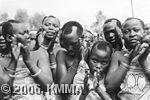
Within the marriage ceremony and in their didactic role, dance songs reminded the newly-weds of
their respective and mutual duties, evoked the problems associated with divorce, stigmatized the
misadventures of arranged marriages, which were prevalent in the old Rwanda, and set the standards
for the household chores that children should carry out and those that went beyond. They also
extolled the virtues of having many children.
-
It could also have a laudatory character: extolling leaders, singing the praises of
heroes' glorious deeds, and commending the beauty of the hills and rivers of Rwanda, the
evening sun, the Rwandese woman, or the ankole cow with its lyre-shaped horns. The polyphonic
Twa songs should be mentioned here along with certain Hutu songs that are performed in the
evenings and songs by Tutsi women and the Gogwe people in which cattle, and especially cows,
are praised.
b) The structure of the dance songs
Dance songs have a responsorial structure, with a chorus that remains the same throughout the
song and is repeated by a group of singers. The chorus comes after each verse, of which there
are usually many and which are started by a soloist
 .
Dance songs have a simple or complex
measured rhythm, with metric accentuation (strong beats and weak beats), pathetic
accentuation or expressive accentuation (a qualifying rhythm 'expressing the inner-most
feelings of the soul' (Mbonimana, 1971: 41). They are traditionally vocal. The melody, either
in unison or polyphonic, is accompanied by the clapping of hands, which supports the rhythm
and indicates the time to the singers and dancers. A number of musical instruments have gradually
been added to this type of percussion with the hands: first the ingoma drum (small in size),
but also the inanga zither, the ikembe sansa (a type of lamellophone), the
umuduri (umunahi) musical bow, the indingiti fiddle and the ihembe horn.
In some regions of Rwanda, the ikinyuguri, agakenke or agahubano rattles,
the igicunda cruche and all the insengo whistles have always accompanied dance
songs. It is worth pointing out that except for the island of Nkombo, where the ikinyuguri
rattle accompanies the secular dance songs, in the other regions of Rwanda, this same rattle,
together with the inzogera bell, supports the rhythm of ritual songs, those of the cult
of Lyangombe in particular. The small amayugi bells traditionally worn by the Intore
warrior dancers around the ankles are increasingly worn by the imbyino dancers
.
Dance songs have a simple or complex
measured rhythm, with metric accentuation (strong beats and weak beats), pathetic
accentuation or expressive accentuation (a qualifying rhythm 'expressing the inner-most
feelings of the soul' (Mbonimana, 1971: 41). They are traditionally vocal. The melody, either
in unison or polyphonic, is accompanied by the clapping of hands, which supports the rhythm
and indicates the time to the singers and dancers. A number of musical instruments have gradually
been added to this type of percussion with the hands: first the ingoma drum (small in size),
but also the inanga zither, the ikembe sansa (a type of lamellophone), the
umuduri (umunahi) musical bow, the indingiti fiddle and the ihembe horn.
In some regions of Rwanda, the ikinyuguri, agakenke or agahubano rattles,
the igicunda cruche and all the insengo whistles have always accompanied dance
songs. It is worth pointing out that except for the island of Nkombo, where the ikinyuguri
rattle accompanies the secular dance songs, in the other regions of Rwanda, this same rattle,
together with the inzogera bell, supports the rhythm of ritual songs, those of the cult
of Lyangombe in particular. The small amayugi bells traditionally worn by the Intore
warrior dancers around the ankles are increasingly worn by the imbyino dancers
 .
.
Some vocal polyphonies of Twa dance are supported by amakondera horns
 .
The recordings
held by the RMCA, which date back to the 1950s, contain dance or danceable melodies and rhythms
supported by a harmonica or by an accordion
.
The recordings
held by the RMCA, which date back to the 1950s, contain dance or danceable melodies and rhythms
supported by a harmonica or by an accordion
 or even by a whistle of Western origin
or even by a whistle of Western origin
 ,
all of which
were gradually abandoned after the independence of Rwanda, for reasons that are not very clear.
Today the dance songs in the urban areas are supported by a variety of Western instruments:
the guitar, the electric organ, drums, saxophone and trumpets. J. Gansemans writes
about the interaction between Rwandan music and the instruments that are used in it in Les
Instruments de Musique du Rwanda (1988), which now serves as reference on the subject, and is in
fact the only one to give an overall view.
,
all of which
were gradually abandoned after the independence of Rwanda, for reasons that are not very clear.
Today the dance songs in the urban areas are supported by a variety of Western instruments:
the guitar, the electric organ, drums, saxophone and trumpets. J. Gansemans writes
about the interaction between Rwandan music and the instruments that are used in it in Les
Instruments de Musique du Rwanda (1988), which now serves as reference on the subject, and is in
fact the only one to give an overall view.
The dance polyphonies of the Twa have a lavish melodic and rhythmic richness that is coupled
with an indescribable choreographic richness. The songs of the Twa of the ancient royal court
(Urwiririza, Ishyaka, Abangakurutwa) are true gems in the collection of the RMCA.
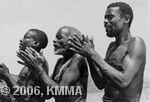
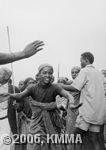
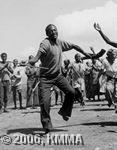
2) The Indirimbo songs
Besides the Imbyino dance songs, the Rwandans have always sung Indirimbo songs,
which differ from the first in that they almost always have a free rhythm, in other words
'one which, instead of having equal time divisions, obeys the general movement of a sentence
or part of a sentence as imposed by the text. Indeed in Rwandan music the tonality of the
words and vocal input play an important part in the musical composition as the words help
create a rhythmical emotive state' (Mbonimana, 1971: 40). Although this rhythm is not used
in dance songs or by drums, it is found in a certain number of other musical genres called
Indirimbo, which are briefly discussed below.
-
Lullabies and love songs: songs to pacify crying children
 .
The rhythm of the song goes
hand in hand with the movement of the mother rocking the child in her arms or on her back.
Note that the Rwandan word igihozo has several meanings: soothing song,
to pacify children; consolation song, to console the betrothed who is about to get married
.
The rhythm of the song goes
hand in hand with the movement of the mother rocking the child in her arms or on her back.
Note that the Rwandan word igihozo has several meanings: soothing song,
to pacify children; consolation song, to console the betrothed who is about to get married

 ;
love song, for an adult person, either from a woman to a man or from a man to a woman.
;
love song, for an adult person, either from a woman to a man or from a man to a woman.
In relation to the soothing song to pacify the child, the technique of Ubuhuha is worthy
of note, i.e. the tune being whistled or whispered through the lips holding both hands together
around the mouth in the shape of a conch. This technique is mainly used by women
 .
.
-
Fairytales, legends and historical or pseudo-historical accounts: this is the sung category

 ,
because there is also a spoken version of the adventures of Lyangombe for instance.
,
because there is also a spoken version of the adventures of Lyangombe for instance.
The songs mentioned in the first two points here could be sung either without instrumental
accompaniment or accompanied by a solo instrument such as the inanga zither, the
indingiti fiddle, the umuduri musical bow
or the ikembe sansa
 .
.
-
The recitation of dynastic poems, which seems to be a separate genre and lies somewhere
between a spoken account and song
 .
.
-
The songs related to work and/or certain vital activities:
-
The farmers' songs: Kwidoga: in contrast to the ploughmen's songs referred
to above which have a measured rhythm and can therefore give rise to dancing, the farmers'
songs have a free rhythm and are known under the Rwandan name of Kwidoga: or to
sing to encourage someone in their work
 .
This term is also used for the songs of
encouragement of the Intore warrior dancers, who sing it as they dance in rows
.
This term is also used for the songs of
encouragement of the Intore warrior dancers, who sing it as they dance in rows
 .
.
-
The travellers' songs: Kwitonga, which are melodically and rhythmically close
to the Kwidoga of the farmers, differ from them only in the content of the texts sung.
They were sung by the travellers carrying food on their way back from market and bartering exchanges
 .
.
-
The boatmen's songs: Amasare
 :
the most interesting - the RMCA holds a few examples
of these - were those of the canoe-makers, which set the rhythm when the canoes were taken from
where they were made to where they would be used.
:
the most interesting - the RMCA holds a few examples
of these - were those of the canoe-makers, which set the rhythm when the canoes were taken from
where they were made to where they would be used.
-
The beekeepers' songs: Amavumbu: in which they praised the value of the bees as
producers of honey, with which the Rwandans made medicines, but also and particularly as
producers of mead
 .
.
-
The blacksmiths' songs: texts sung and recited in the Urucuzi jargon
of the blacksmiths, which has completely disappeared today.
-
The hunting songs: Amahigi: there were several forms of hunting in Rwanda.
The best known, because they were the most common and the most celebrated, are hunting with
bow and arrow and hunting with hounds or with 'bells', a metonymy for hunting
with dogs that wore bells.
The songs for the hunt with bow and arrow, Amahigi y'umuheto, can be divided
into four categories:
-
The Kwasira song: a lyrical evocation of the hunting expeditions
during which the hunter who sings or his company have made a name for themselves.
The singing often alternates with the ihembe horn (one or several responding to each other).
-
The Kwirahira recitation: when the hunter's chasing feats are told over
the carcass of the animal that has just been killed.
-
The Urukumo chant: sung by the hunters responsible for beating
the bushes to drive out the game. In the representation of the hunt, these chants
alternate with the Kwirahira recitations.
-
The dance songs, Imbyino, which closed the ceremony where the yield
from the hunt was presented to the king or to the regional or local authority
 .
.
The songs for the hunt with 'bells', Amayogera, can also be divided into four categories:
-
The Kwasira song: a lyrical evocation and reminiscence of the hound's
exploits. One or several inzogera or hunting bell/bells is/are shaken by one
or several hunters to support the rhythm of the song.
-
The Gukabukira: verses harshly addressed to the dog to excite him during the beat.
-
The Agahege or ikobe: cries made by a hunter to which the
others respond to give each other courage and signal their respective positions. In the
representation of the hunt, these cries alternate with the Gukabukira phase.
-
The dance songs which, as in the hunt with bow and arrow, closed the ceremony where
the yield from the hunt was presented to the king or to the regional or local authority
 .
.
At this point three points are worthy of note:
-
In all the songs of reminiscence described above, the hunters often evoke their ancestors
or the Imandwa spirits of the cult of Lyangombe, which they associate with
hunting and whom they ask for protection and good luck.
-
Elephant hunting gave rise to songs whose structure was different from the songs described here.
-
Hunting in Rwanda as a whole was not organized to provide hunters with venison. Few Rwandans
ate venison. They hunted deer because of their love of adventure, as a sport and/or because
of their love of danger.
-
The pastoral songs: we have seen how the Rwandans glorify three animals:
two domestic animals, i.e. the cow and the hunting hound, and a third - semi-domestic
- animal, i.e. the bee. Of the three, the cow is held in the highest regard. They glorify
the cow with several songs, all of which, together, can be considered as a sub-group
of recited pastoral poetry, which was very sophisticated and formed part of what
Alexis Kagame (1969) calls the 'three great lyric genres of Ancient Rwanda':
pastoral poetry dedicated to the royal cow Inyambo, war poetry and dynastic poetry,
since the three were encouraged by or were even attached to certain royal institutions.
There are many pastoral songs, but no study has as yet been devoted to them: these are:
-
the Amahamba song: the best known and most commonly sung by the Rwandans,
sung when the shepherds returned from moving their flocks to a different pasture,
during the time when the sheep were in season - Kubangurira, or in the
evening when they returned from grazing their flocks
 ;
;
-
the Imyoma song, whose name evokes the pastures in the valleys and on the hillsides
 ;
;
-
the Amajuri song, evoking the pastures of the dark forests
 ;
;
-
the Ibyiisigo song: a category of songs performed at drinking troughs at the
moment when the shepherds fill them with saline water;
-
the Amayungu song: song whose melody is close to that of the Amajuri,
or that of the Imyoma. It evokes the return of rain and the hope of recovering pastures;
-
the Indama song;
-
the Imhima song,
and many others.
Comments:
-
Some of these songs take sections from odes of pastoral poetry dedicated
to the royal cow Inyambo.
-
Some of the dance songs of the Tutsi women are based on these songs (sung by men),
the category of Amajuri songs for instance, of which they take certain themes and sections.
Official pastoral poetry evokes the social and economic value of the cow, its beauty,
its gait, its white horns in the shape of a lyre, the good fortune of its owners, the
terrible epidemics that have struck the herds such as the cattle plague, Muryamo
(1890-1891; 1934), about which the RMCA holds many songs devoted to its evocation.
-
The warriors' songs: since war is a primeval human activity, defending and/or
extending the national territory, it is befitting to include these songs here among the
songs related to work and/or certain vital activities. In fact, for the Úlite of old
Rwanda, war was a trade or a craft for which young people were trained from an early age.
Warriors' songs were part of this training and according to A. Kagame (1969), it was
one of the secondary genres of Rwandan epic literature.
Two of these genres have had an effect over time:
-
the Indirimbo z'ingabo warriors' songs, which always go together with
the recitation of the ibyivugo or 'talking about oneself', self-praising
odes of war which every man recites in an excited tone and which they learnt as part
of the training of every Rwandan male
 .
.
-
the Indirimbo z'ibihayi songs of praise, which were also related to war.
In the military organization of old Rwanda, every militia (which A. Kagame also refers to as
armée sociale [social or citizen army]) was made up of several companies.
Every militia and every company had its own warriors' song or 'hymn'. These songs were
handed down from one generation to another. They were generally sung by the warriors during
evening gatherings around the king or military chiefs. That is why these types of song recorded
by the RMCA are designated 'songs for evening gatherings' or 'warriors' songs'. Over time they
began to be sung among the population.
The tradition of the Rwandan militia in this sphere was of course continued by the warrior
dance troupes, most of whom had their own 'warriors' songs', which they sang in the lines
of battle during shows or during evening gatherings. This tradition was maintained by the
football teams from the moment the sport was introduced to Rwanda.
These songs, which had
incited courage and a competitive spirit among the armies and the companies, increased the
competitive spirit among these teams, which were of a different nature but the organization
of which to some extent took over the spirit of emulation of the ancient militia.
It is worthy of note that the songs or 'hymns' sung by these football teams, which now no
longer exist, were influenced by Western Gregorian music, which is not surprising as the
missionaries of the order of the White Fathers who taught this music to the Rwandan people
were also the creators and subsequently ardent supporters of these teams. Many of these songs
can be found among the RMCA recordings
 .
.
DANCE
Up until now we have only dealt with dance that stems from the Imbyino songs.
Now we shall - succinctly - discuss a type of dance that follows other canons than those
connected with these songs. This is mainly dance connected with the warriors' parades or
dance whose choreography obeys the rules of these parades.
1) Imyiyereko
The old Rwandan armies performed Imyiyereko dances, which, according to
Curt Sachs's classification (World History of the Dance, 1957) are both individual and group
dances, armed and pantomimic. They were performed by groups of paraders-cum-dancers famed
for their fitness, who entered the stage in single file using the Ururenge step
to the rhythm of a song, an ingoma drum or an ihembe horn and
stood in a line facing the spectators. A number of dancers would then come out of the line
to dance solos supported by cries and encouragement from the group behind them. There was
a parade for every war weapon and every parade had its own steps and movements; there was
a parade for the bow, for the lance, the shield, the sword and the combat knife
 .
.
The military code of old Rwanda (Kagame, 1952) refers to the training undergone by the young
recruits drawn from the aristocracy. Article 25 of the code specifies the daily activities
of these recruits, the main one being the Umuhamirizo warriors' dances
described below, but also parade exercises: with the bow, the sword, target-shooting,
javelin-throwing and various jumps, which went together with learning the paeans and odes to
war and many other disciplines.
2) Dance in warriors' rituals
A certain number of rituals were organized at the royal court and among the population
of Rwanda during times of war. Among these rituals, organized by people who were not
taking part in the fighting, there were songs and dances performed by the women of the
group called Banyamhumbya, those-in-charge-of-the-magic-herbs, at the
royal court around the sacred fire.
3) The Umuhamirizo dance
Alexis Kagame claims that the Umuhamirizo warriors' dance was only recently
introduced in Rwanda (19th century). It is the result of the
combination of a parade dance from Burundi and the Rwandan lance parade. It was initially
a palace dance, performed at the royal court, before spreading to the main chiefs and even
to the rest of the population. As suggested above, from the outset it was one of the
disciplines the royal pages had to acquire during their warrior and citizen training.
It was an armed, pantomimic group dance, in which certain fighting and battle scenes were
recreated. Further information about this dance can be found in J.B. Nkulikiyinka's
Introduction à la danse rwandaise traditionnelle, 2003.
The polyphonic music of the Amakondera aerophones, which appeared at the same
time and was supported by two drums, ruharage and ingaraba, was
linked to that of this dance from the time it first arrived in Rwanda, probably during the
reign of king Musinga. From then on, the Amakondera, which were a speciality of the
Twa people, accompanied the entrance onto the stage of the Intore dancers
(who perform the Umuhamirizo dance), gave rhythm to the solos by the best dancers
and accompanied them again as they left the stage. This music, with its rich sounds,
was also played during royal evening gatherings or during evening gatherings of some
of the main chiefs.
4) The Umurambiro parade dance of the Inkaranka
The Umurambiro parade dance of the Inkaranka should normally be
included in the Imyiyereko parades. We are discussing it separately here for several
reasons. Firstly it came from outside, from somewhere in eastern Congo. Secondly its
choreography is different from the other Rwandan parades in that the body movements it
favours do not follow the canons of Rwandan dance in general and of the parades in particular.
Thirdly they were performed by a single group of Rwandan warriors, the Inkaranka, in the north-west
of Rwanda in the region of Bugoyi (Gisenyi).
5) The hoe dance of the Imharamba
The hoe dance is usually called by the name of the Imharamba dancers who perform it.
Its origins lie in the farming rituals related to the fertility of the soil and glorifies
the hoe and its socio-economic role. It is danced in one region of Rwanda, the Bufundu
region (Gikongoro) towards the south-west of Rwanda. Although it is therefore far removed
from wars and warriors, its different forms of choreography (it is performed as a kind of
mini ballet) are organized in a similar way to that of the warriors' parades: the dancers
enter the stage in single file using the same Ururenge step, to the rhythm of
a horn or an ingoma drum; some dancers perform solos with the hoe, which is
seen as a metaphor for the combat weapon; and the dancers leave the stage in exactly the
same way as the warriors ending their parade
 .
.
BIBLIOGRAPHY
Bourgeois, R., 1957, Banyarwanda et Barundi
d'Hertefelt, M., 1962, Les Anciens Royaumes de la Zone Interlacustre Meridionale
d'Hertefelt, M. et Coupez, A., 1964, La Royauté Sacrée de l'Ancien Rwanda
Gansemans, J., 1988, Les Instruments de Musique du Rwanda
Jacob, I., 1983, Dictionnaire Rwandais-Franšais (Extrait du Dictionnaire de l'INRS)
Kagame A., 1962, Les Milices du Rwanda Précolonial
Kagame, A., 1969, Introduction aux Grands Genres Lyriques de l'Ancien Rwanda
Mbonimana, G., 1971, Musique Rwandaise Traditionnelle
Nkulikiyinka, J.B., 2003, Introduction Ó la Danse Rwandaise Traditionnelle
Sachs, Curt., 1957, The World History of the Dance
Vansina, J., 1962, L'Evolution du Royaume Rwanda, des origines à 1900
© KMMA/Jean Baptiste NKULIKIYINKA

 In Rwanda there is music that gives rise to dance, Imbyino, and music that is
simply for listening, Indirimbo. This art was often associated with poetry and
eloquence. Music, dance and poetry have always been the most spectacular expressions of
Rwandan culture. They constitute elements of identity and socialization and as such have
pervaded the lives of this nation of farmers, shepherds and herdsmen, potters and other
craftsmen. They are transmitted orally and reflect the history, the fundamental values, the
view of the world and the customs of the Rwandans.
In Rwanda there is music that gives rise to dance, Imbyino, and music that is
simply for listening, Indirimbo. This art was often associated with poetry and
eloquence. Music, dance and poetry have always been the most spectacular expressions of
Rwandan culture. They constitute elements of identity and socialization and as such have
pervaded the lives of this nation of farmers, shepherds and herdsmen, potters and other
craftsmen. They are transmitted orally and reflect the history, the fundamental values, the
view of the world and the customs of the Rwandans.













